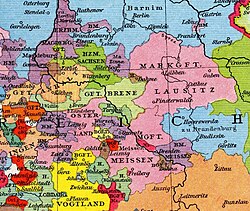This article needs additional citations for verification. (October 2006) |
Duchy of Saxe-Wittenberg Herzogtum Sachsen-Wittenberg (German) | |||||||||
|---|---|---|---|---|---|---|---|---|---|
| 1296–1423 | |||||||||
 Duchy of Saxe-Wittenberg (green, centred on the town of Wittenberg) | |||||||||
| Status | Duchy of the Holy Roman Empire | ||||||||
| Capital | Wittenberg | ||||||||
| Religion | Roman Catholic | ||||||||
| Government | Feudal Duchy | ||||||||
| Dukes | |||||||||
• 1296–1298 | Albert II of Ascania[a] | ||||||||
• 1298–1356 | Rudolf I of Ascania | ||||||||
| Historical era | Middle Ages | ||||||||
• Definite partition from Saxony | 1296 | ||||||||
| 1423 | |||||||||
| 1423 | |||||||||
| |||||||||
| Today part of | Germany | ||||||||
a: Albert II was co-ruler of undivided Saxony, with John I, from 1260 | |||||||||
The Duchy of Saxe-Wittenberg (German: Herzogtum Sachsen-Wittenberg) was a medieval duchy of the Holy Roman Empire centered at Wittenberg, which emerged after the dissolution of the stem duchy of Saxony. The Ascanian dukes prevailed in obtaining the Saxon electoral dignity until their duchy was finally elevated to the Electorate of Saxony by the Golden Bull of 1356.

